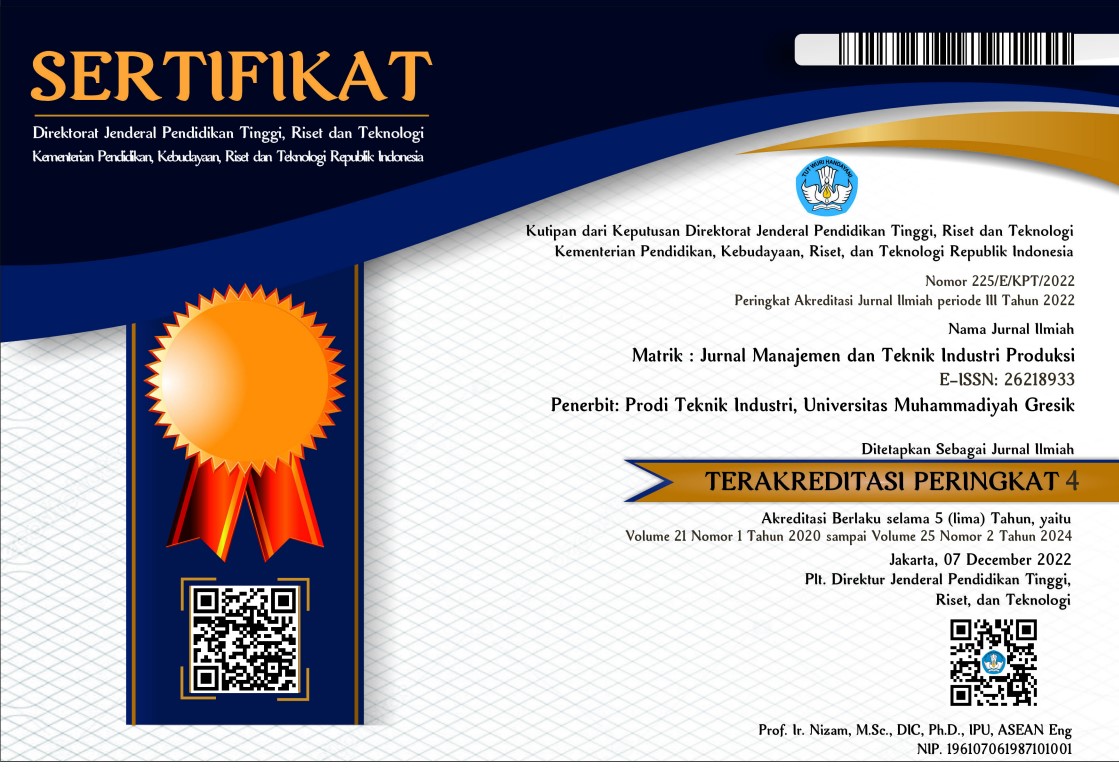Perlunya Pengembangan Pengukuran Kinerja Sustainable Service Supply Chain di Provinsi Jawa Timur
DOI:
https://doi.org/10.30587/matrik.v21i1.1458Keywords:
pengukuran kinerja, sustainable service supply chain, karakter intangibility, BSC, DEMATEL.Abstract
Industri jasa menyerap tenaga kerja dan mempengaruhi pertumbuhan ekonomi. Sektor jasa di Jawa Timur yang mempunyai kontribusi tinggi dalam PDRB 2019: pariwisata, akomodasi dan makanan minuman; jasa perusahaan serta kesehatan dan sosial. Implementasi supply chain (SC) dan pengukuran kinerja diyakini dapat digunakan untuk menjaga keberlanjutan pertumbuhan industri jasa.
Industri jasa yang menerapkan SC dituntut stakeholder untuk berpihak pada masyarakat dan kelestarian lingkungan. Pada sisi lain, sektor jasa dipengaruhi oleh karakter intangibility dalam operasionalnya. Dari fenomena ini, konsep pengukuran kinerja sustainable service SC (SSSC) yang yang memperhatikan aspek ekonomi, sosial dan lingkungan serta karakter intangibility secara simultan dapat diimplementasikan guna menjaga eksistensi dan kontribusi sektor jasa di Jawa Timur. Perancangan kerangka kerja konseptual untuk pengukuran kinerja SSSC di Provinsi Jawa Timur dapat mengadopsi model pengukuran kinerja BSC yang diintegrasikan dengan DEMATEL, dimana BSC digunakan sebagai model utama dalam mengukur kinerja, sedangkan DEMATEL merancang peta strategi dalam BSC.
Dari kajian literatur diketahui bahwa finansial, pelanggan, operasional, informasi serta inovasi dan pembelajaran merupakan perspektif kinerja yang sering digunakan dalam pengukuran kinerja service SC sehingga dapat diadopsi. Perspektif informasi dan perspektif inovasi dan pembelajaran merupakan perspektif yang dapat menaungi indikator kinerja yang bersifat intangibility yang berorientasi pada sumberdaya manusia. Indikator aspek lingkungan yang dapat diadopsi: konsumsi energy dan air, pengelolaan limbah, konservasi alam, emisi CO2, konsep reduce, reuse dan recycle, green service dan material ramah lingkungan.
Perspektif inovasi dan pertumbuhan merupakan perspektif yang paling berpengaruh karena mempengaruhi capaian kinerja dari semua perspektif. Sedangkan perspektif pelanggan merupakan perspektif terpenting karena semua perspekktif diarahkan untuk perspektif pelanggan
References
[2] T. Baltacioglu, E. Ada, M. D. Kaplan, O. Yurt And, and Y. Cem Kaplan, “A new framework for service supply chains,” Serv. Ind. J., vol. 27, no. 2, pp. 105–124, 2007.
[3] M. Giannakis, “Conceptualizing and managing service supply chains,” Serv. Ind. J., vol. 31, no. 11, pp. 1809–1823, 2011.
[4] J. Drzymalski, “Supply Chain Frameworks for the Service Industry : A Review of the Literature,” Eur. Int. J. Sci. Technol., vol. 1, no. 3, pp. 31–42, 2012.
[5] D. W. Cho, Y. H. Lee, S. H. Ahn, and M. K. Hwang, “A framework for measuring the performance of service supply chain management,” Comput. Ind. Eng., vol. 62, no. 3, pp. 801–818, Apr. 2012.
[6] M. Giannakis, “Management of service supply chains with a service-oriented reference model: the case of management consulting,” Supply Chain Manag. An Int. J., vol. 16, no. 5, pp. 346–361, 2011.
[7] BPS Jawa Timur, “Pertumbuhan Ekonomi Jawa Timur Triwulan II-2019,” Ber. Resmi Stat., vol. Triwulan 2, 2019.
[8] BPS, East Java in Figure 2015. BPS - Statistics of Jawa Timur Province, Surabaya, Indonesia, 2015.
[9] C. L. Comm and D. F. X. Mathaisel, “Sustaining higher education using Wal-Mart’s best supply chain management practices,” Int. J. Sustain. High. Educ., vol. 9, no. 2, pp. 183–189, 2008.
[10] C. Blanchard, C. L. Comm, and D. F. X. Mathaisel, “Adding value to service providers: benchmarking Wal-Mart,” Benchmarking An Int. J., vol. 15, no. 2, pp. 166–177, 2008.
[11] M. Habib, “Supply chain management : theory and its future perspectives,” vol. 1, no. 1, pp. 79–87, 2010.
[12] E. Chardine-Baumann and V. Botta-Genoulaz, “A Framework For Sustainable Performance Assessment Of Supply Chain Management Practices,” Comput. Ind. Eng., vol. 76, pp. 138–147, Aug. 2014.
[13] G. A. Akyuz and T. E. Erkan, “Supply chain performance measurement: a literature review,” Int. J. Prod. Res., vol. 48, no. 17, pp. 5137–5155, Sep. 2010.
[14] S. Shaw, D. B. Grant, and J. Mangan, “Developing environmental supply chain performance measures,” Benchmarking An Int. J., vol. 17, no. 3, pp. 320–339, 2010.
[15] E. Hassini, C. Surti, and C. Searcy, “A literature review and a case study of sustainable supply chains with a focus on metrics,” Int. J. Prod. Econ., vol. 140, no. 1, pp. 69–82, Nov. 2012.
[16] J. Linton, R. Klassen, and V. Jayaraman, “Sustainable supply chains: An introduction,” J. Oper. Manag., vol. 25, no. 6, pp. 1075–1082, Nov. 2007.
[17] X. Xu and D. Gursoy, “A conceptual framework of sustainable hospitality supply chain management,” J. Hosp. Mark. Manag., pp. 1–31, 2014.
[18] E. Ortas, J. M. Moneva, and I. Álvarez, “Sustainable supply chain and company performance : A global examination,” Supply Chain Manag. An Int. J., vol. 19, no. 3, pp. 332–350, 2014.
[19] M. Varsei, C. Soosay, B. Fahimnia, and J. Sarkis, “Framing sustainability performance of supply chains with multidimensional indicators,” Supply Chain Manag. An Int. J., vol. 19, no. 3, pp. 242–257, 2014.
[20] B. Marr and C. Adams, “The balanced scorecard and intangible assets : similar ideas , unaligned concepts,” Meas. Bus. Excell., vol. 8, no. 3, pp. 18–27, 2006.
[21] K. Zigan and D. Zeglat, “Intangible resources in performance measurement systems of the hotel industry,” Facilities, vol. 28, no. 13/14, pp. 597–610, 2010.
[22] S. A. Melnyk, U. Bititci, K. Platts, J. Tobias, and B. Andersen, “Is performance measurement and management fit for the future?,” Manag. Account. Res., vol. 25, no. 2, pp. 173–186, Jun. 2014.
[23] X. Zhang, H. Song, and G. Q. Huang, “Tourism supply chain management: A new research agenda,” Tour. Manag., vol. 30, no. 3, pp. 345–358, Jun. 2009.
[24] P. Beske-janssen, M. P. Johnson, and S. Schaltegger, “20 years of performance measurement in sustainable supply chain management – what has been achieved ?,” Supply Chain Manag. An Int. J., vol. 20, no. 6, pp. 664–680, 2015.
[25] R. S. Kaplan and D. P. Norton, “Linking the Balanced Scorecard to strategy,” Calif. Manage. Rev., vol. 39, no. 1, pp. 53–79, 1996.
[26] R. S. Kaplan and D. P. Norton, “Response to S. Voelpel et al., ‘The tyranny of the Balanced Scorecard in the innovation economy,’ Journal of Intellectual Capital, Vol. 7 No. 1, 2006, pp. 43-60,” J. Intellect. Cap., vol. 7, no. 3, pp. 421–428, 2006.
[27] R. S. Kaplan, D. P. Norton, and B. Rugelsjoen, “Managing alliances with the Balanced Scorecard,” Harv. Bus. Rev., no. February 2010, pp. 114–121, 2010.
[28] E. B. Leksono, Suparno, and I. Vanany, “Development of conceptual framework for sustainable supply chain performance measurement in service industries,” in 8th Widyatama International Seminar on Sustainability, 2016, pp. 142–148.
[29] I. Gölcük and A. Baykasoglu, “An analysis of DEMATEL approaches for criteria interaction handling within ANP,” Expert Syst. Appl., vol. 46, pp. 346–366, 2016.
[30] F. Chen, T. Hsu, and G. Tzeng, “A balanced scorecard approach to establish a performance evaluation and relationship model for hot spring hotels based on a hybrid MCDM model combining DEMATEL and ANP,” Int. J. Hosp. Manag., vol. 30, no. 4, pp. 908–932, 2011.
[31] E. B. Leksono, Suparno, and I. Vanany, “Development of Performance Indicators Relationships on Sustainable Healthcare Supply Chain Performance Measurement Using Balanced Scorecard and DEMATEL,” Int. J. Adv. Sci. Eng. Inf. Technol., vol. 8, no. 1, pp. 115–122, 2018.
[32] E. B. Leksono, S. Suparno, and I. Vanany, “Integration of a Balanced Scorecard , DEMATEL , and ANP for Measuring the Performance of a Sustainable Healthcare Supply Chain,” Sustainability, vol. 11, no. 3626, pp. 1–18, 2019.
[33] N.-O. Hohenstein, E. Feisel, and E. Hartmann, “Human resource management issues in supply chain management research,” Int. J. Phys. Distrib. Logist. Manag., vol. 44, no. 6, pp. 434–463, 2014.
[34] S. Matos and J. Hall, “Integrating sustainable development in the supply chain: The case of life cycle assessment in oil and gas and agricultural biotechnology,” J. Oper. Manag., vol. 25, no. 6, pp. 1083–1102, Nov. 2007.
[35] X. Font, R. Tapper, K. Schwartz, and M. Kornilaki, “Sustainable supply chain management in tourism,” Bus. Strateg. Environ., vol. 17, pp. 260–271, 2008.
[36] M. Sigala, “A supply chain management approach for investigating the role of tour operators on sustainable tourism: the case of TUI,” J. Clean. Prod., vol. 16, no. 15, pp. 1589–1599, Oct. 2008.
[37] A. Wolfson, D. Tavor, and S. Mark, “From CleanTech to CleanServ,” vol. 5, no. 3, pp. 193–196, 2013.
[38] G. Büyüközkan and G. Cifci, “An integrated QFD framework with multiple formatted and incomplete preferences : A sustainable supply chain application,” Appl. Soft Comput., vol. 13, pp. 3931–3941, 2013.
[39] W. J. V. Vermeulen and M. T. J. Kok, “Government interventions in sustainable supply chain governance: Experience in Dutch front-running cases,” Ecol. Econ., vol. 83, pp. 183–196, Nov. 2012.
[40] K. Gopalakrishnan, Y. Y. Yusuf, A. Musa, T. Abubakar, and H. M. Ambursa, “Sustainable supply chain management: A case study of British Aerospace (BAe) Systems,” Int. J. Prod. Econ., vol. 140, no. 1, pp. 193–203, Nov. 2012.
[41] K. Schwartz., R. Tapper, and X. Font, “A sustainable supply chain management framework for tour operators,” J. Sustain. Tour., vol. 16, no. 3, pp. 298–314, 2008.
[42] B. Adriana, “Environmental supply chain management in tourism: The case of large tour operators,” J. Clean. Prod., vol. 17, no. 16, pp. 1385–1392, Nov. 2009.
[43] B. Keating, A. Quazi, A. Kriz, and T. Coltman, “In pursuit of a sustainable supply chain: insights from Westpac Banking Corporation,” Supply Chain Manag. An Int. J., vol. 13, no. 3, pp. 175–179, 2008.
[44] C. Brindley and L. Oxborrow, “Aligning the sustainable supply chain to green marketing needs: A case study,” Ind. Mark. Manag., vol. 43, no. 1, pp. 45–55, Jan. 2014.
[45] A. Tajbakhsh and E. Hassini, “A data envelopment analysis approach to evaluate sustainability in supply chain networks,” J. Clean. Prod., Aug. 2014.
[46] C. F. Gomes, M. M. Yasin, and J. V. Lisboa, “The effectiveness of hospitality service operations : measurement and implementation concerns,” Int. J. Contemp. Hosp. Manag., vol. 19, no. 7, pp. 560–573, 2007.
[47] P. Chithambaranathan, N. Subramanian, and A. Gunasekaran, “Service supply chain environmental performance evaluation using grey based hybrid MCDM approach,” Intern. J. Prod. Econ., no. 166, pp. 163–176, 2015.







